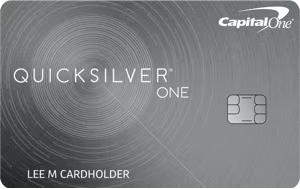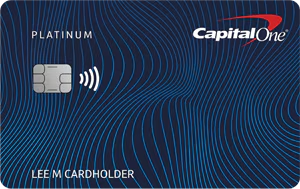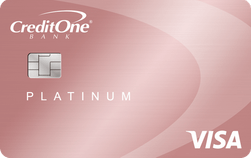I’ve been writing about personal finance and credit cards since 2006. Unlike most websites that only show you cards that are paid affiliates, I recommend cards I think are best, whether or not they advertise.
A credit score between 650 and 699 is about average. It’s not bad, but it’s not quite good enough to get approved for the best credit cards that offer lots of rewards and benefits. Until your credit improves, you should look for a card that you can get approved for and that doesn’t rip you off! If it has some modest benefits, that’s a plus. The three cards I recommend in this credit range not only offer a good chance of approval, but good value, too.

Capital One QuicksilverOne
$39 annual fee. Earn an unlimited 1.5% cash back on all purchases; 5% cash back on hotels and rental cars booked through Capital One Travel.

Capital One Platinum
$0 annual fee.
Credit One Bank® Platinum Rewards Visa® with No Annual Fee
No annual fee for qualified applicants. Get 2% cash back rewards on eligible gas and grocery purchases as well as mobile phone, internet, cable, and satellite TV services. Terms apply.
Capital One QuicksilverOne Cash Rewards Credit Card
We think the Capital One QuicksilverOne Cash Rewards Credit Card is the best credit card for average credit because of the generous 1.5% cash back and Capital One’s reputation as an accommodating credit card issue for cardmembers with a range of credit scores.
Capital One QuicksilverOne Cash Rewards Credit Card

Information about the Capital One QuicksilverOne Cash Rewards Credit Card has been collected independently by Money Under 30. Please confirm terms on the card issuer's website. Offer details verified on Apr. 29, 2024.
Welcome Offer
No welcome offer or sign-up bonus offered.
Rewards
Earn an unlimited 1.5% cash back on all purchases; 5% cash back on hotels and rental cars booked through Capital One Travel.
Annual Fee
$39 annual fee.
Our Thoughts
This is perhaps the best credit card for those with just fair credit that would still like to earn cash back on all their purchases. Cardholders miss out on a sign-up bonus and there's an annual fee, but they also avoid the good to excellent credit requirement that comes with other rewards cards, like with the Quicksilver version.
The Capital One QuicksilverOne Cash Rewards Credit Card has a very attractive cash rewards offer for consumers with average credit. You can earn 1.5% cash back on all purchases, and there are no rotating spending categories requiring you to adjust your activity every quarter. The card also comes with $0 fraud liability, free credit score monitoring, and auto rental collision damage waiver. If you start with a low credit limit, you will be eligible for automatic increases after making just six on time monthly payments.
To get the most out of this card, make your payments on time every month, and Capital One will begin reviewing your credit limit after just six months. This will not only provide you with a good credit reference, but the potential for a higher credit limit may improve your credit utilization ratio.
The major drawback of cash back credit cards — ironically — is that they may cause you to spend more money than you otherwise would because you think “Hey, I’m getting cash back on this!” If you know that you might be tempted to overspend with a credit card, consider the Capital One Platinum Card instead. It doesn’t offer rewards, but that may work in your favor if your primary goal is to get a credit card to use responsibly while rebuilding credit.
» MORE: Read our full Capital One QuicksilverOne Cash Rewards Credit Card review
Credit One Bank® Platinum Rewards Visa® with No Annual Fee
The Credit One Bank® Platinum Rewards Visa® with No Annual Fee is a no-annual fee credit card that pays 2% cash back on eligible gas, grocery, mobile phone, internet, cable, and satellite TV purchases.
Credit One Bank® Platinum Rewards Visa® with No Annual Fee
- No annual fee for qualified applicants. Terms apply.
- Get 2% cash back rewards on eligible gas and grocery purchases as well as mobile phone, internet, cable, and satellite TV services. Terms apply.
- Choose your monthly payment due date for added convenience. Terms apply.
- Free Online Credit Score and Credit Report summary, terms apply
- Enjoy peace of mind with $0 Fraud Liability.
- Stay in-the-know with customizable account alerts via email and text.
- Manage your account on-the-go with the Credit One Bank mobile app.
- If you are a Covered Borrower under the Military Lending Act, you may get a different offer
- See Rates & Fees
| Annual Fee | Intro APR, Purchases | Intro APR, Balance Transfers | Regular APR | Credit Needed |
| $0 | N/A | N/A | 28.99%* Variable | Good/Excellent |
The Credit One Bank® Platinum Rewards Visa® with No Annual Fee is a good option for consumers who can’t get approved for a prime cash back credit card to earn cash back where they spend most without needing to pay an annual fee.
You’ll need to think about which card — this card or QuicksilverOne, mentioned above — will be a better deal. While this card only pays cash back in certain categories, it pays 2% compared to the QuicksilverOne card’s 1.5%. If you’re going to use your credit card mostly to fill up your tank, buy groceries, and pay bills, this might be the card for you.
» MORE: See card details/apply
Capital One Platinum Credit Card
The Capital One Platinum Credit Cardis a no-frills credit card for those on the lower end of the average credit score range, who are mostly interested in either rebuilding or improving their credit score. The card doesn’t offer cash back rewards or points. But it does offer $0 fraud liability, and auto rental collision damage waiver benefits.
Capital One Platinum Credit Card

Information about the Capital One Platinum Credit Card has been collected independently by Money Under 30. Please confirm terms on the card issuer's website. Offer details verified on Apr. 29, 2024.
Welcome Offer
No welcome offer or sign-up bonus offered.
Rewards
No rewards offered on spending.
Annual Fee
$0 annual fee.
Our Thoughts
There's no introductory offer, rewards on spending or long list of attractive perks offered, but this credit card works as a solid tool for those with fair credit looking for help to build credit over time with responsible use while spending less on fees.
This is really a card designed for those with fair credit, but in the credit card universe, even a credit score in the mid-600s could be considered fair. If you’ve been unable to get a credit card elsewhere, this one is an excellent choice. As long as you pay off your balance monthly, it will be a cost-effective way to improve your credit score, particularly since there’s no annual fee.
The only reason you might avoid this card is because you qualify for a card that also includes cash back rewards or points. Otherwise it’s an excellent card to rebuild or improve your credit score.
» MORE: Read our full Capital One Platinum Credit Card review
How we came up with our list of the best cards 650 to 690 credit score
So, you’ve just scrolled through our top picks for credit cards suited for creidit scores between 650 and 690. You might be wondering how we landed on those choices. Let’s explain our process.
Our research process
To make our picks for the best credit cards for average credit, we began by looking at over 200 credit cards issued by major U.S. bank, as well as some from lesser-known banks and credit unions. Because most credit cards require very good or excellent credit for approval, we quickly narrowed the list to a few dozen cards available to applicants with average credit scores.
What we looked for
Here’s a breakdown of our selection criteria:
- Interest rates: We started with the basics. A competitive APR can make a significant difference in how much you pay over time.
- Rewards and benefits: We’re all about maximizing value. We searched for cards that offer solid rewards, whether it’s cash back, travel perks, or points.
- Fees: No one likes hidden costs. We prioritized cards with clear fee structures and, where possible, no annual fees.
- User reviews: Real feedback from actual users can be incredibly telling. We took into account the experiences of others to gauge the overall satisfaction of cardholders.
- Flexibility: Life can be unpredictable. We appreciate cards that offer some wiggle room, be it in payment options or grace periods.
- Customer support: Often overlooked, customer service is an important intangible feature of your credit card. How responsive is the customer support? Are there resources available to educate cardholders? A company’s support can make or break the user experience.
The competition
In addition to our three picks, we looked at a number of other cards that, while great, didn’t make our final cut.
Discover it® Student Card
These included student credit cards, which are marketed to college students who typically don’t yet have lengthy credit histories. We especially like the Discover it® Student Card. Discover has done student cards well for many decades. Their student card pays between 1% and 2% cash back and has no annual fee.
Mission Lane Cash Back Visa Card
You might also consider the Mission Lane Cash Back Visa Card, a no annual fee credit card with up to 1.5% cash back and automatic credit line reviews after 7 months.
Credit cards to avoid
When shopping for a credit card for average credit, be wary of cards that advertise “easy” or “guaranteed” approval. There are cards designed for applicants with bad credit and they are very bad deals. They often come with high annual fees and very low credit lines.
Summary of the best credit cards if your FICO score is 650 to 699
In the table below, we summarized the main information for each of the cards we presented as the best cards if your FICO score is between 650 and 699:
| Card/category | Credit line increases? | Sign-on bonus offer | Rewards |
|---|---|---|---|
| Capital One QuicksilverOne Cash Rewards Credit Card | Yes, reviewed after six months | N/A | 1.5% unlimited cash back all purchases |
| Credit One Bank® Platinum Rewards Visa® with No Annual Fee | Upon request | N/A | 2% cash back in select categories |
| Capital One Platinum Credit Card | Yes, reviewed after six months | N/A | N/A |
Not your credit range? See the best credit cards for FICO scores between 600 and 650 or credit cards for very good credit (better than 700 credit score) instead.


